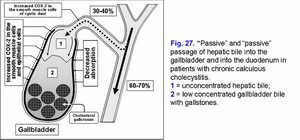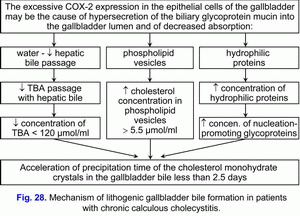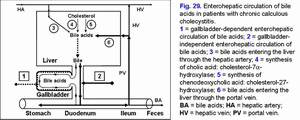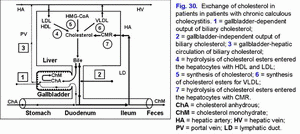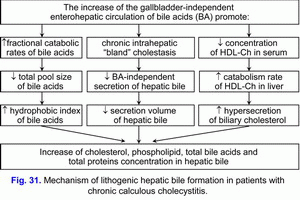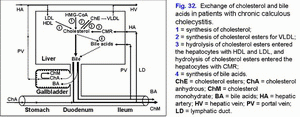
Русский | English
Gallstone Disease |
Gallstone disease is a disease of hepato-biliary system, caused by cholesterol and/or bilirubin metabolic disorder, and characterized by formation of stones in the gallbladder and/or the biliary tract (1). Gallstones are categorized as cholesterol, mixed, black pigment, or brown pigment stones (2). Cholesterol gallstones are the main type of gallstones and contain cholesterol as the major chemical constituent. Mixed cholesterol gallstones are composed of more than 50% cholesterol (2). Cholesterol and mixed gallstones are formed from biliary sludge, which stays for a long time in the gallbladder lumen. Biliary sludge consists of calcium bilirubinate granules, cholesterol monohydrate crystals, and biliary polymerized glycoprotein mucin (2-8). The dynamics of the transformation of biliary sludge into cholesterol stones has been shown as follows: diffused biliary sludge → surface biliary sludge → precipitating biliary sludge → a cholesterol gallstone without acoustic shadow → a cholesterol gallstone with acoustic shadow (9). The time of formation of cholesterol stones depends on the intensity of the precipitation processes of cholesterol monohydrate crystals in biliary sludge, and equals 3 to 36 months (2). Transformation proportion varies from 5 to 50% depending on the cause (2). Black pigment stones are composed of either pure calcium bilirubinate or polymer-like complexes consisting of calcium, cooper, and large amounts of mucin glycoproteins. Brown pigment stones are composed of calcium salts of unconjugated bilirubin, with varying amounts of cholesterol and protein. These stones are usually associated with infection (2). The natural history of gallstones is typically defined in two separate groups of patients: those with symptomatic gallstones and those who are asymptomatic. The vast majorities of gallstones are asymptomatic and remain asymptomatic (2). As a rule, gallstone disease is asymptomatic, which is called “silent” stones. The rate of development of biliary pain is approximately 2% per year for 5 years and then decreases over time. The incidence of complications in patients with asymptomatic stones is low, and prophylactic removal of the gallbladder for this condition is not necessary (2). Patients who had an episode of uncomplicated biliary pain in the year, 38% per year had recurrent biliary pain (2). An incidence of recurrent biliary pain as high as 50% per year in those with symptomatic gallstones. 30% of patients with one episode of biliary pain will not have a recurrent episode (2). The estimated risk of developing biliary complications is estimated to be 1% to 2% per year and is thought to remain relatively constant over time (2). If biliary pain occurs in the right upper abdomen and the gallbladder wall inflames, gallstone disease transforms into chronic calculous cholecystitis. Chronic calculous cholecystitis is an inflammatory disease which affects the gallbladder wall and causes motoric-tonic dysfunctions of the biliary system, accompanied by presence of gallstones in the gallbladder lumen, and reveals as biliary pain (1, 3). The motoric dysfunction of the gallbladder can be caused by increased basal common bile duct resistance, muscle hypertrophy, and chronic inflammation in the gallbladder wall. Biliary colic is the most common presenting symptom of cholelithiasis. Approximately 75% of patients with symptomatic gallstone disease seek medical attention because of episodic abdominal pain (2). The syndrome of biliary colic is caused by intermittent obstruction of cystic duct by gallstones (2). Cholecystectomy should be offered to patients only after significant biliary symptoms develop. Diagnostic criteria of the chronic calculous cholecystitis
Causes of the gallbladder evacuation dysfunction, biliary pain and chronic inflammation in the gallbladder wall
Mechanism of development of pathologic disordersHigh degree of COX-2 expression in the smooth muscle cells of the gallbladder wall causes the decrease of the evacuation function of gallbladder and “active” passage of hepatic bile into the gallbladder (fig. 27). Surplus COX-2 expression in the epithelial cells of the gallbladder mucosa makes for decrease of the absorption function of the gallbladder (decrease of water and biliary cholesterol absorption) and “passive” passage of the hepatic bile into the gallbladder (fig. 28). Also, gallstones volume in the gallbladder lumen may be the cause of decreased “active” and “passive” passage of the hepatic bile into the gallbladder (from 50% to 5%). This is accompanied by decrease in concentration of total bile acids in the gallbladder bile and increase of concentration of biliary cholesterol in phospholipid vesicles, and causes disturbance in colloidal stability of gallbladder bile and precipitation of the cholesterol monohydrate crystals from unstable multilamellar aggregated phospholipid vesicles and calcium bilirubinate granules, i.e. formation of “lithogenic” gallbladder bile (fig. 28). Also, increased COX-2 expression in the epithelial cells of the gallbladder mucosa activates the hypersecretion of glycoprotein mucin into the gallbladder lumen and gallbladder bile. The increase of the concentration of the glycoprotein biliary mucin in the gallbladder bile over 2.0 mg/ml causes its polymerization and formation of sites of the excessive viscosity and it is accompanied by rise of gallbladder bile viscosity. Precipitation of cholesterol monohydrate crystals and calcium bilirubinate granules in the sites of the excessive viscosity of polymerized glycoprotein biliary mucin causes the formation of biliary sludge, the increase in its echogenicity and its revelation during ultrasound examination. The decrease in “active” and “passive” passage of the hepatic bile into the gallbladder causes increase of passage of hepatic bile into duodenum and gallbladder-independent enterohepatic circulation of bile acids, biliary cholesterol and biliary bilirubin (fig. 29). The increase in the gallbladder-independent enterohepatic circulation of bile acids causes increase of concentration of bile acids in the hepatocytes and the decrease in the accumulation function and excretion function of the liver (i.e. formation of chronic “bland” intrahepatic cholestasis) (fig. 29). The increase of the gallbladder-independent enterohepatic circulation of biliary cholesterol causes increase of absorption of the biliary cholesterol in the small intestine, the biliary cholesterol entering hepatocytes and hypersecretion biliary cholesterol into hepatic bile (fig. 30). These two factors contribute to the formation of the “lithogenic” hepatic bile (fig. 31). The decrease in the gallbladder-dependent output of biliary cholesterol and in the concentration of total bile acids in the gallbladder bile cause the formation of the “lithogenic” gallbladder bile and the precipitation of cholesterol monohydrate crystals in the gallbladder lumen among patients with chronic calculous cholecystitis (fig. 32). Long-term storage of gallstones and chronic aseptic inflammation in the infundibulum mucosa of the gallbladder may cause the acute gallbladder obstruction of infundibulum and transformation of the chronic calculous cholecystitis into acute calculous cholecystitis, which need urgent surgical treatment. Pathogenetic treatment of patients with chronic calculous cholecystitisAccordingly, treatment of chronic calculous cholecystitis (with biliary pain) aiming for prophylactics of the acute calculous cholecystitis, duodeno-gastral reflux, antral atrophic (bile-acid-dependent) gastritis and chronic biliary pancreatitis includes:
Celebrex (Celecoxib) is a selective inhibitor of COX-2. Inhibiting COX-2 activity in the smooth muscle cells of the gallbladder wall and cystic duct it brings relief of the biliary pain within 3-5 days, restoration of the evacuation function of the gallbladder and the gallbladder-dependent output of biliary cholesterol, “active” and “passive” passage of the hepatic bile into the gallbladder, and decrease in the gallbladder-independent enterohepatic circulation of bile acids, biliary cholesterol and biliary bilirubin. Celebrex (Celecoxib), a selective inhibitor of COX-2, inhibiting COX-2 activity in the epithelial cells of the gallbladder mucosa causes inhibition of the glycoprotein mucin hypersecretion into the gallbladder lumen, concentration of glycoprotein biliary mucin in gallbladder bile and viscosity of gallbladder bile, which prevents formation of biliary sludge. Low COX-2 activity in the epithelial cells of the gallbladder mucosa helps restoring the absorption function of the gallbladder (absorption of water and biliary cholesterol from phospholipid vesicles), which results in increase of concentration of total bile acids and decrease of concentration of biliary cholesterol in the gallbladder bile. Also, low COX-2 activity in the epithelial and smooth muscle cells of the gallbladder infundibulum helps lowering the risk of development of acute calculous cholecystitis. Ursofalk (ursodeoxycholic acid), is a hydrophilic hepatoprotective bile acid. It helps in dissolving the cholesterol monohydrate crystals in the gallbladder, decrease of lithogenicity of gallbladder and hepatic bile, disappearance of the chronic “bland” intrahepatic cholestasis (i.e. results in the restoration of the accumulation and excretion functions of liver) and in some patients helps in dissolving cholesterol gallstones. Celebrex (Celecoxib) and Ursofalk (ursodeoxycholic acid), blocking main pathogenetic mechanisms of gallstones formation, help in slowing down the growth of cholesterol gallstones and lower the risk of acute calculous cholecystitis. In some patients the chronic calculous cholecystitis can transfer into the gallstone disease (without biliary pain) or the “silent” gallstones group. Estimated effectiveness is 95%.
Attention!!! Information for patients: Before using this scheme of treatment please check the contraindications (below) and side effects of using pharmacological preparations of Celebrex (Celecoxib) and Ursofalk (ursodeoxycholic acid), and obtain your doctor’s permission. Contraindications for Celebrex (Celecoxib):
Contraindications for Ursofalk (ursodeoxycholic acid):
This web page does not bear any legal responsibility for the use of the proposed treatment schemes without consulting your doctor. References:
|
|
|
